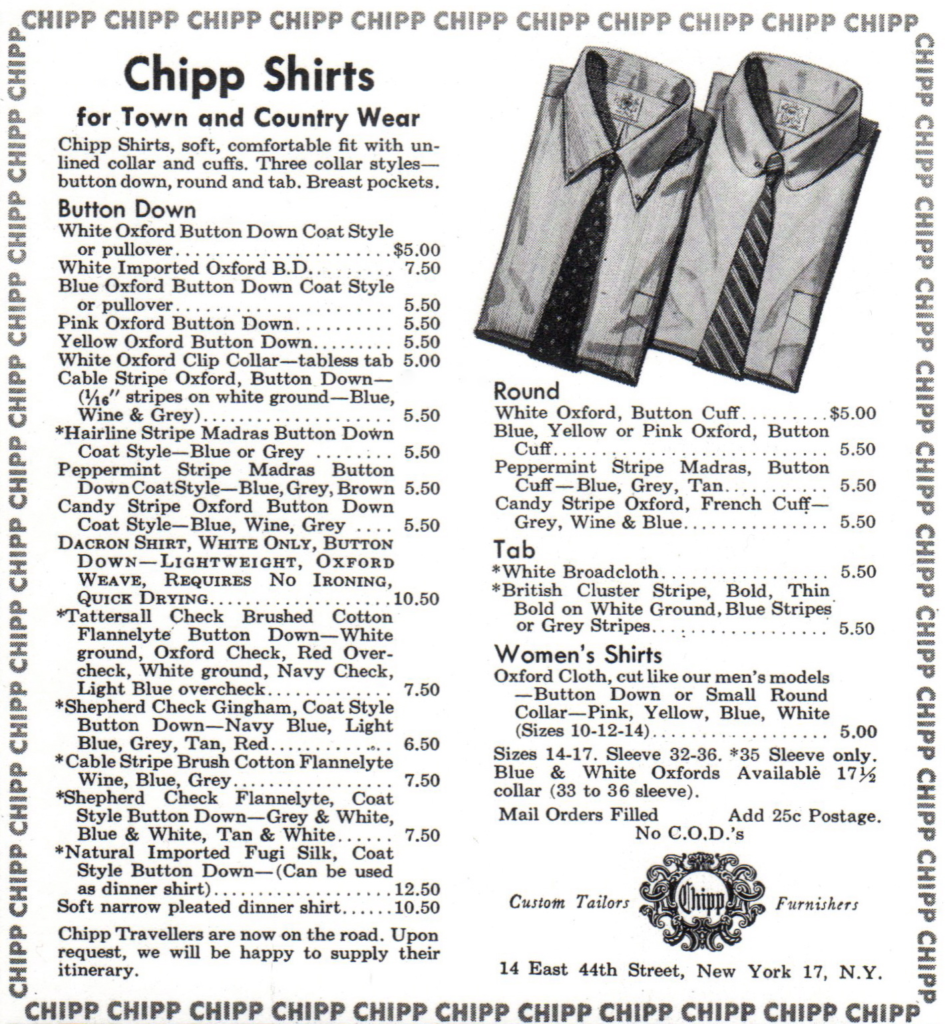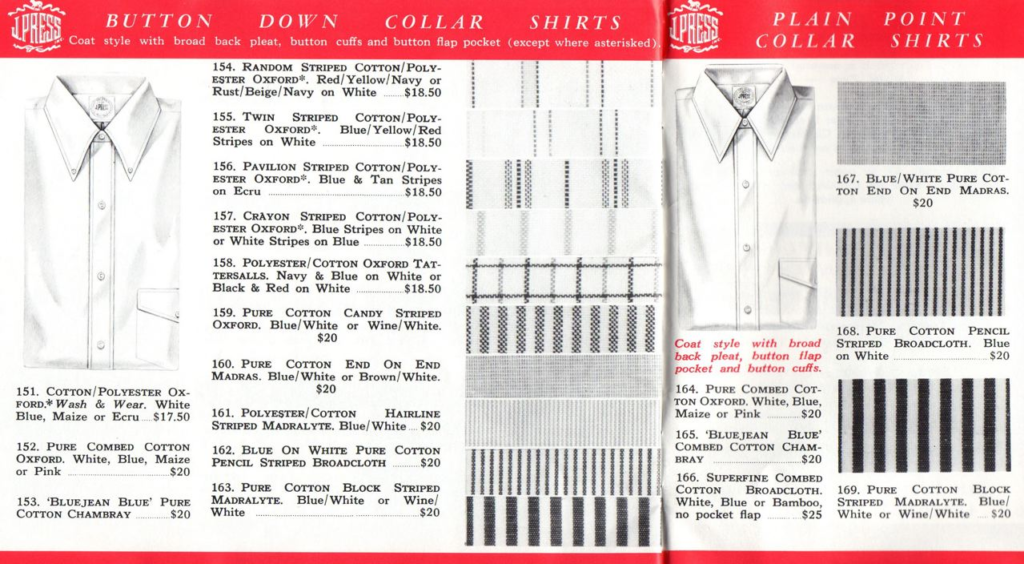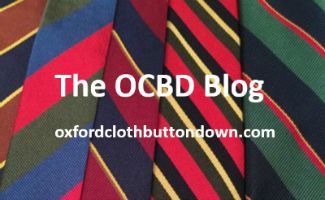This is a re-post from the now defunct and my favorite trad blog ever, Heavy Tweed Jacket (HTJ). I stumbled on this old blog post as I was researching the fabric of old end-on-end shirt that I have. In this post from May 2013 HTJ goes in depth on his favorite summer fabric, end-on-end Madras. He touches on all the reasons that I like end-on-end fabrics in the summer, introduces a term that I was not familiar with (end-on-end madras), and of course takes us down memory lane. Buckle you seatbelt and prepare for a blast from the past.
As far as favorites go, end-on-end Madras runs a pretty close second to oxford cloth for me. Though this very thin fabric looks great with tweed and can be worn year round, it really comes into its own in the warmer months of the year. End-on-end Madras is both light in weight and highly breathable, hence its great utility in the warmer seasons of the year. In the past, these shirts were often seen in both solid colors as well as candy stripes. Many men’s clothiers also offered shirts made of end-on-end Madras in both button-down and straight point collars. End-on-end is a very thin fabric that looks great when starched to paper thinness and worn with a jacket, though it also dresses down equally well with khakis and loafers for those who like a bit of casual rumple. The shirts pictured above are from bottom to top: Brooks Brothers Brookscloth (blue); Mercer & Sons (blue); Huntington Clothiers (blue): Brooks Brothers (blue): Brooks Brothers Brookscloth (brown candy stripe); Brooks Brothers Brookscloth (spice candy stripe); Brooks Brothers Brookscloth (blue candy stripe); and Brooks Brothers (blue candy stripe).
End-on-end Madras is a fabric known for its alternating warp yarns, usually one in white and one in color. It is also known for its distinctive box weave formed by slightly thicker yarns repeated at intervals on the weft. I’ve always understood that this bit of texture created by the thicker yarns why it is referred to as ‘Madras’. J. Press used to offer shirts made from their own unique fabric called ‘Madralyte’ which did not have the box weave effect. I’ve never had one of these shirts, but I imagine it would have been like an end-on-end broadcloth: a shirt with the feel of end-on-end but without the box weave. With end-on-end Madras, when seen from a distance, solid colors such as blue or pink appear as truly solid, but when examined closely, a very fine white box or check-like pattern gives the shirt a subtle texture. The true character of end-on-end Madras lies in its durability and thinness, becoming softer with age. This is a very light and breathable fabric that is at its best when the collars and cuffs are unlined or lined with only the thinnest of fabrics. When starched, the collars and cuffs become as thin as paper offering an elegant counterpoint to tweeds or summer linen, silk and wool blends. Shirts made of this cloth were once a very common staple for men, but today these shirts have become somewhat hard to find. About the only places that I can think of that still offer shirts of this fabric are Mercer & Sons, O’Connell’s, and J. Press (more on that below).
However, I thought that it would be interesting in this post to take a historical look at how venerable clothiers such as Brooks Brothers, Chipp and J. Press have offered these shirts over the years. It remains mystifying to me why more clothiers do not offer this unpretentious, hard-wearing and yet elegant shirt.
Brooks Brothers, Spring & Summer 1962. Brooks Brothers offered an English end-on-end broadcloth button-down shirt in this catalog from half a century ago.
Brooks Brothers, Christmas 1971. The striped shirts in #143 (a) certainly look like they were made from end-on-end cloth. They also have that very definite heavy-early-’70s-vibe happening. It really is hard to believe that only nine years separate this catalog from those immediately above and below.
Brooks Brothers, Spring and Summer 1980. The Brooks Brothers solid blue end-on-end Madras was the gold standard for this shirt. Brooks unlined polo collar and narrow unlined cuffs gave this shirt a certain understated yet beautiful simplicity.
Brooks Brothers, Fall & Winter, 1982. Brooks Brothers used to offer these shirts year round and the fall and winter catalogs seemed to feature them more than the catalogs for spring and summer.
Brooks Brothers, Fall & Winter 1981. Throughout the 1980s Brooks Brothers also offered a solid blue end-on-end shirt with contrasting collar and cuffs.
Brooks Brothers, Fall 1987. I had one of these in the broadcloth version in the 1980s, and it wore well with suits or with a blazer.
Brooks Brothers, Christmas 1980. Brooks Brothers also offered an easy care polyester and cotton blend called ‘Brookscloth’ that came in both solid and candy striped end-on-end versions. The shirt construction was the same as the all cotton shirts, and to me at any rate, it was also far superior to the contemporary non-iron shirts made by Brooks Brothers today. As I’ve said before, the non-iron shirts of today are almost too well made – perfection rendering them somewhat lifeless. These older Brookscloth versions were, if I might say it this way – pretty cool.
Brooks Brothers, Fall 1988. A somewhat rare photo catalog showing both solid and striped end-on-end versions of this shirt. Other than oxford cloth, I can’t think of a more useful cloth for daily wear wear than this.
Chipp (The New Yorker, 10/16/1954). However, in addition to Brooks Brothers, Chipp also offered a ‘Peppermint Stripe Madras’, which I am betting was their version of a candy stripe end-on-end Madras. These were offered in blue, grey and brown stripes. I wish I could call Chipp up on the phone and order a couple of these.
J. Press, Fall & Winter 1977. Of course, J. Press also offered end-on-end Madras in solid blue with that distinctive box weave. J. Press also offered ‘Madralyte’, a fabric with much of the same character as end-on-end Madras, but without the box weave effect. The J. Press stripes were also very distinctive, with hairline and block striped Madralyte offerings.
J. Press, Fall & Winter 1980. This page from the 1980 J. Press Brochure is a great example of their lineup with solid blue end-on-end, hairline Madralyte, pencil stripe Madralyte, block stripe Madralyte, as well as crayon stripe broadcloth and the old standard oxford cloth candy stripes. I would also like to have a telephone that would connect me with J. Press in 1980. Now that would be my kind of smartphone.
I’ve included some photos that show mainly Brooks Brothers’ end-on-end shirts from the 1980s, as well as Huntington Clothiers and Mercer and Sons’ shirts.
‘Makers’ All Cotton, Blue Candy Stripes. Late 1980s.
Brookscloth (65/35 blend), Blue Candy Stripes. Late 70s, early 1980s. A 60/40 cotton/polyester blend came out after this (see below).
‘Makers’ All Cotton, Blue. Late 1980s.Brooks all cotton solid blue version was a lighter shade of blue.
Huntington Clothiers, Egyptian Cotton, Blue. Late 1980s. Huntington’s version was closest in color to Brooks’ all cotton version.
‘Makers’ Brookscloth (60/40 blend), Blue. Late 1980s. The 60/40 blend version. Pretty nice collar roll.
Mercer & Sons, All Cotton, Blue. Mercer’s version is very nice indeed. I like a full cut shirt, and these shirts are absolutely comfortable to work in all day long.
A new-old-stock Brookscloth in a brown candy stripe. This Brookscloth blend may be a decidedly ‘unhip’ 65/35 poly-cotton blend, but these shirts are just as well made as their all cotton cousins and have that “Brooksy” button-down collar roll. If this makes me unhip, then so be it. I wouldn’t have it any other way. Brooks Brothers seems to have forgotten how to make shirts like this. I keep hoping that they will wake up like Rip van Winkle and reclaim their place as ‘Makers’ of ‘The Most Imitated Shirt in the World’.
So whether one needs solids or stripes, end-on-end Madras shirts are a classic choice that can be worn all year round. Today, one might be a bit hard pressed to find these shirts at Brooks Brothers. I couldn’t find much that looked like this on their website. However, one need not lose hope. O’Connell’s, J. Press and Mercer & Sons all still offer shirts cut from this cloth. O’Connell’s selection, though not wide, offers a standard blue end-on-end button-down. J. Press offers a solid blue end-on-end in a not often seen straight point collar; a pink button-down; as well as a hard to find blue thin stripe end-on-end button-down. Mercer & Sons can make shirts in a various shades of end-on-end blue, as well as the colors “thistle” and peach. They also offer a candy-stripe-like “Bold” stripe end-on-end in blue. So choices are still available for this type of shirt. The weather is only going to get warmer, so it is only natural that shirts like this will no doubt find a frequent place in the rotation. End-on end Madras: A classic workhorse of a shirt that I can only hope will continue to be offered for years to come. The world needs more living traditions such as this.






















Fantastic. Thank you so much for bringing these articles back. I have been going over those pages on the archives as well, for while. I wish the higher res photos were still available. Great commentary and perspective, I wish he was still actively posting. There are so many things I would love to discuss.
I have a few of these BB end to ends, including examples from the 1960s (or late 50s), 70s, and 80s. Sellers usually confuse them with Chambray for some reason.
I would love a new label dating discussion as well. HTJ rightly pin points the end of the 6 button front being 1987/88 (year of the Spencer Buyout). Though we know the 2 line label begins in 1972, the introduction of the 3 line label (there are two different font 3 line labels!) and its accompanying country of material origin and construction origin, shortly thereafter, is probably mid 1980s. Once the 7 button style takes over in 1988, the labels go through a variety of changes in quick session into the later 80s and 90s and just ads to the confusion of dating but I sieve looking at the catalogs can help as well as they do include actual pictures in which the labels are visible.
Keep up the great work!
Irving,
Thank you. You are preaching to the choir. We need HTJ back! Thanks for all the knowledge that you dropped too. I think that I had one of these end-on-end shirts way back when from Huntington Clothiers that I had thought was a chambray. I wish that I still had it to examine.
Nice article Ox, thanks for re-posting it.
I thrifted a light blue end on end Brooks shirt a few years ago and still wear it each Summer. It’s a bit short in the sleeves, but it’s probably one of my favorite Summer cloth asides from Pique or Jersey knit cottons. I might have to try ordering some more soon.
Jerrod, have you ever seen an end on end club collar shirt in the wild? There’s one pictured above but I’ve never seen one worn in pictures asides from point collars or occasionally button down collars from Kamakura.
Thanks, Tie Clip. Great find, it sounds like a nice shirt! I can’t say that I have, but I have seen very few club collars in the wild.